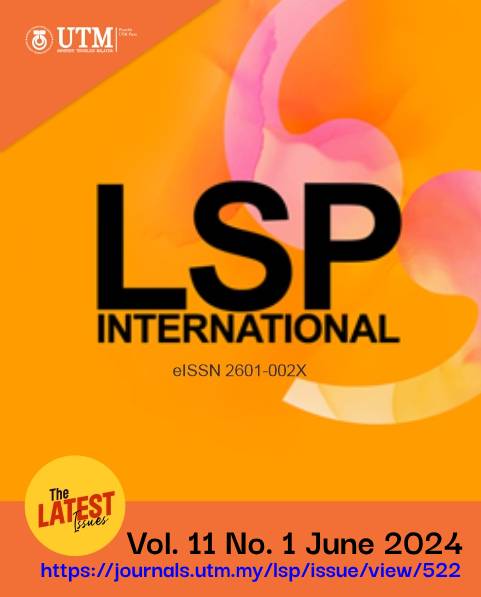Pedagogical Practices of Speaking Skill Instruction in Secondary Schools
DOI:
https://doi.org/10.11113/lspi.v11.22575Keywords:
Language Pedagogy, Teacher Strategies, Student Engagement, Assessment Methods, Instructional TechniquesAbstract
Effective speaking skills are crucial in language education as they enhance communication and boost confidence in various social and professional settings. The research attempts to identify the various techniques, methods, and strategies employed by secondary level English teachers in teaching speaking skills at secondary level. The study employed descriptive survey design with a quantitative approach to investigate speaking skill instruction in Lumbini province, Nepal. The target population included 480 secondary-level English teachers with a minimum of five years of teaching experience. Stratified simple random sampling ensured representation from community and institutional schools. Data collection utilized a structured questionnaire with 45 open-ended questions, distributed electronically to ensure anonymity. Findings revealed disparities in time allocation for speaking instruction between community and institutional schools. Most teachers allocate one or two periods per week, with institutional schools dedicating more time. Emphasis on fluency, accuracy, or both varies, with a majority focusing on both aspects. Learner-centered techniques are favored for engaging students, with role play and prepared talks common activities. Motivational techniques include questioning, classroom discussions, and role assignment. Preferred pronunciation improvement techniques involve imitation and recording exercises. Materials like pictures and newspapers are frequently used, while audio devices are favored for teaching. Testing techniques focus on oral questions and picture description. Preferred teaching techniques include picture describing and dialogue/interview/prepared talks. Effective classroom environment and management emphasize well-managed classrooms and limited student numbers. Overall, practices in institutional schools show a greater emphasis on learner-centered approaches and varied activities compared to community schools.
References
Brown, H. D. (2007). Principles of language learning and teaching. Pearson.
Brown, J. (2017). Challenges in speaking instruction: A comparative study of community and institutional schools. Journal of Language Education, 20(3), 45-58.
Davis, R. (2018). Enhancing speaking skills through motivational techniques: A case study of secondary-level EFL/ESL classrooms. Language Teaching Research, 30(2), 112-125.
Dina, Al & Ghadeer, Al. (2014). An investigation of the difficulties faced by EFL undergraduates in speaking skills, English Language Teaching, 7(1), 19-27. https://doi.org/10.5539/elt.v7n1p19.
Gan, Z. (2012). Understanding L2 speaking problems: Implications for ESL curriculum development in a teacher training institution in Hong Kong, Australian Journal of Teacher Education, 37(1), 43-59. https://doi.org/10.14221/ajte.2012v37n1.4.
Gebhard, M., & Oprandy, R. (1999). Language teaching awareness: A guide to exploring beliefs and practices. Cambridge University Press.
Hosni, S. (2014). Speaking difficulties encountered by young EFL learners. International Journal on Studies in English Language and Literature (IJSELL), 2(6), 22-30.
Indonesian Journal of EFL and Linguistics, 1(1), 47-61. https://doi.org/10.21462/ijefll.v1i1.4.
Johnson, L. (2018). Factors influencing time allocation for speaking instruction: A comparative analysis of community and institutional schools. Language Education Journal, 15(1), 78-91.
Jones, S., Smith, A., & Martinez, P. (2019). Prioritizing speaking in institutional schools: Resource availability and pedagogical approaches. Journal of Educational Psychology, 25(2), 189-202.
Kayi, H. (2006). Teaching speaking: Activities to promote speaking in a second language. The Internet TESL Journal, 12(11), 45-57.
Lee, G. (2009). Speaking up: Six Korean students’ oral participation in class discussions in US graduate seminars. English for Specific Purposes, 28(3), 142-156 https://doi.org/10.1016/j.esp.2009.01.007.
Luoma, S. (2004). Assessing speaking. Cambridge: Cambridge University Press. https://doi.org/10.1017/CBO9780511733017.
Martinez, P., Thompson, K., & Rodriguez, E. (2021). Understanding variations in speaking instruction: Insights from secondary-level EFL/ESL classrooms. Journal of Applied Linguistics, 40(1), 56-68.
Nguyen, T., Wilson, M., & Brown, J. (2020). Learner-centered approaches to speaking instruction: Implications for language teaching. Modern Language Journal, 35(4), 301-314.
O'Malley, J. M., & Chamot, A. U. (1990). Learning Strategies in Second Language Acquisition. Cambridge, U.K.: Cambridge UniversityPress. https://doi.org/10.1017/CBO9781139524490.
Parker, D. (2017). Utilization of learner-centered techniques in teaching speaking: A qualitative analysis. Applied Linguistics Review, 22(2), 145-158.
Rababa’h, G. (2005). Communication problems facing Arab learners of English. Journal of Language and Learning, 3(1), 1-22.
Razmjoo, S., & Ardekani, S. (2011). A model of speaking strategies for EFL learners. The Journal of Teaching Language Skills (JTLS), 3(3), 115-142.
Rodriguez, E. (2017). Shift towards learner-centered techniques in speaking instruction: An exploratory study. TESOL Journal, 12(3), 201-215.
Sayuri, S. (2016). English Speaking Problems of EFL Learners of Mulawarman University.
Smith, A. (2018). Speaking proficiency and learner motivation: Insights from secondary-level classrooms. Language Teaching Research, 28(1), 45-58.
Smith, J., & Jones, L. (2018). Peer-led discussions and project-based learning: Valuable approaches in high school classrooms for teaching speaking skills. Journal of Education Research, 45(3), 321-335.
Thompson, K., Garcia, M., & Wilson, M. (2019). Enhancing speaking skills through interactive instructional strategies: A case study of secondary-level classrooms. Language Education Journal, 22(2), 112-125.
Ur, P. (1996). A course in language teaching: Practice and theory. Cambridge University Press.
Wilson, M., Martinez, P., & Brown, J. (2020). Learner-centered techniques in speaking instruction: A comparative analysis of community and institutional schools. Journal of Language Education, 18(4), 201-215.
Zhang, S. (2009). The role of input, interaction, and output in the development of oral fluency. English Language Teaching, 2(4), 91-100. https://doi.org/10.5539/elt.v2n4p91.
















